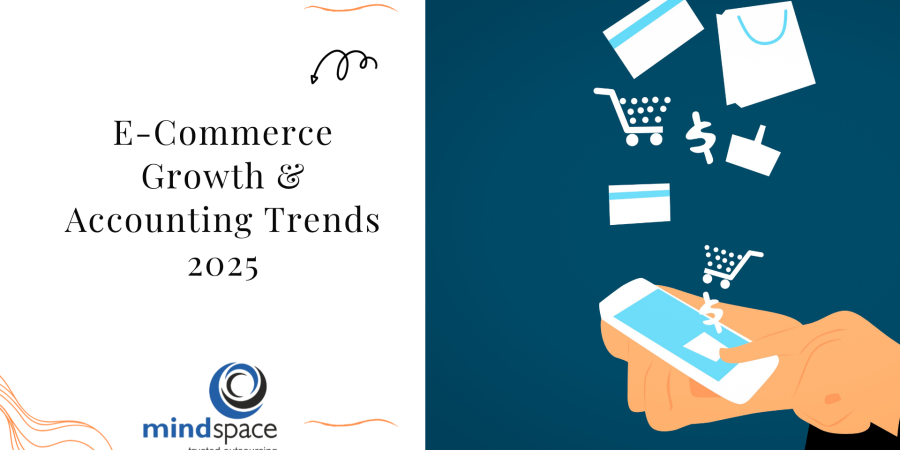E-Commerce Growth & Accounting Trends 2025
The world of e-commerce is developing at a much faster pace than ever, and in 2025, headlines will be focusing on social commerce and live shopping. What began as an experiment combining entertainment with shopping has now become a multi-million-dollar opportunity that brands can’t afford to ignore. Platforms like TikTok, Instagram, YouTube, and Facebook have evolved into digital malls where consumers are entertained, engaged, and persuaded to buy — all without leaving the app.
For e-commerce businesses, mastering these trends is no longer optional. It’s the key to attracting attention, driving conversion, and fostering long-term customer loyalty in a competitive digital landscape. But alongside these marketing innovations, financial accuracy and eCommerce accounting automation are equally vital to ensure sustainable growth and compliance.
Emergence of Social Commerce
Social commerce means selling products directly through social media platforms. Instead of redirecting customers to external websites, shop owners can let users browse, explore, and buy without leaving the app. This frictionless experience shortens the purchase journey, boosts conversion rates, and strengthens real-time engagement.
In 2025, social commerce is expected to exceed $1.5 trillion globally (eMarketer). Why? Because people spend more time on social platforms than ever, and integrated shopping features have turned casual browsing into impulse buying — requiring accurate revenue tracking, automated reconciliation, and digital tax compliance to manage financial flows properly.
Why Social Commerce Is So Powerful
-
Trust through Influencers: Buyers rely on recommendations from creators more than advertisements. When an influencer promotes a product, it feels authentic and credible.
-
Instant Gratification: With “Shop Now” buttons, customers can buy immediately without leaving the app — requiring brands to maintain real-time sales data synchronization for accurate gross profit and COGS tracking.
-
Community Engagement: Likes, comments, and shares make shopping interactive, fostering user-generated content and enhancing brand visibility.
-
Hyper-Personalization: AI-driven algorithms recommend products based on browsing history and trending hashtags — and businesses must use AI accounting tools to analyze customer lifetime value and predict cash flow performance.
The Live Shopping Boom
If social commerce is the digital mall, live shopping is the pop-up event inside it. Popularized in China, it’s now one of the fastest-growing e-commerce strategies globally.
Here’s how it works: A host (celebrity or brand ambassador) goes live, showcases products, interacts with viewers, offers discounts, and drives urgency. Viewers can buy instantly — creating both engagement and transactional data that feed directly into cloud-based accounting systems.
By 2025, live shopping is estimated to contribute 20% of all global e-commerce sales. Brands like Amazon Live, TikTok Shop, and Instagram Live Shopping are heavily investing in this sector.
Why Consumers Love Live Shopping
-
Entertainment + Shopping: It’s fun and engaging, turning purchasing into an experience.
-
Real-Time Interaction: Viewers can ask questions and get instant answers, which improves trust.
-
Exclusive Deals: Time-sensitive discounts and flash sale accounting events drive urgency.
-
FOMO Effect: Limited-time promotions trigger immediate purchases — making real-time revenue recognition and inventory updates crucial.
Winning Strategies for 2025: Social Commerce, Live Shopping, and Accounting Precision
1. Leverage Influencer Partnerships
Micro-influencers drive higher engagement with niche audiences. Partner with those who share your brand values, and use affiliate revenue tracking tools to monitor ROI accurately.
2. Invest in Video-First Strategies
Short-form videos dominate attention on TikTok, Instagram Reels, and YouTube Shorts. Combine this with AI-driven analytics to assess marketing spend efficiency and conversion ROI directly linked to accounting dashboards.
3. Simplify Checkout Experiences
Friction kills sales. Implement one-click payments, secure gateways, and in-app wallets while ensuring PCI compliance and automated bookkeeping integrations for every transaction.
4. Personalize the Shopping Journey
In 2025, AI-powered accounting systems will merge sales data, behavioral analytics, and tax reporting to offer personalized pricing and dynamic discounting — improving customer satisfaction while maintaining profit margin visibility.
5. Build Communities, Not Just Customers
Brands that foster community engagement thrive. Use financial data insights to understand customer acquisition cost (CAC) and measure return on engagement through community-driven campaigns.
Major Platforms Leading the Charge
-
TikTok Shop: A powerhouse in viral content and in-app sales.
-
Instagram & Facebook Shops: Perfect for lifestyle and fashion brands targeting Millennials and Gen Z.
-
YouTube Live Shopping: Great for storytelling and detailed product demos.
-
Amazon Live: Integrates livestreaming directly with inventory and accounting systems for automated reconciliation and profit analytics.
Challenges and How to Overcome Them
-
Oversaturation of Live Events
-
Focus on storytelling and unique, high-value sessions that stand out.
-
Use performance analytics to measure profitability and viewer engagement for each event.
-
-
Lack of Trust and Authenticity
-
Showcase verified customer reviews and testimonials to build credibility.
-
Maintain transparent refund and return accounting processes to reassure customers.
-
-
Tech Integration Issues
-
Invest in cloud-based ERP and accounting systems that seamlessly manage live data, sales tax, and financial reconciliation.
-
Ensure your technology stack supports real-time inventory updates and automated bookkeeping for smooth operations.
-
By 2025, shopping will be woven into daily digital habits. A viral TikTok clip can trigger an instant sale, while live sessions can rival in-store events. Behind this, automated accounting systems, AI financial insights, and multi-channel reconciliation tools will keep businesses compliant, profitable, and scalable.
The winners will not just sell—they’ll entertain, educate, and account accurately.
Final Thoughts
Social commerce and live shopping aren’t passing trends—they’re the new foundation of e-commerce in 2025. But growth demands not just creative marketing, but robust accounting intelligence.
To succeed:
-
Partner with authentic influencers.
-
Prioritize video storytelling.
-
Streamline payment and accounting processes.
-
Build communities backed by data-driven financial insights.
In this era, the future of retail belongs to those who connect emotionally and account intelligently.


